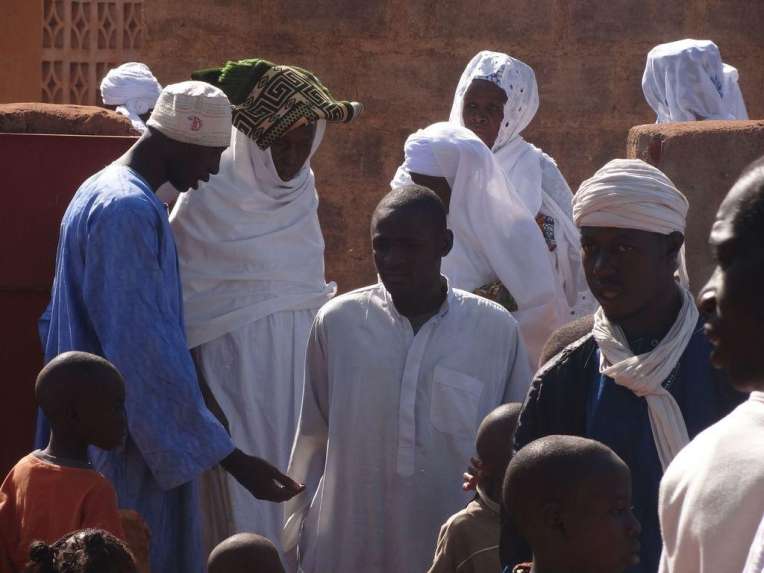Understanding Currents of Islam in Mali
From the Series: Mali, March 2012
From the Series: Mali, March 2012

As political turmoil and violence in Mali have garnered international attention, the role of Islam in Mali has drawn considerable public notice as journalists worldwide have endeavored to characterize Mali’s vast Muslim population for their audiences. These reports often feature an uncompromising divide between radical, Middle Eastern “Salafist” or “Wahhabi” Islamism and African “Sufi” forms of Islam (see, for example Armstrong 2013; Ould Mohamed 2012; Subrahmaniam 2011).

We can improve our understanding of Islam in Mali by recognizing this categorization as problematic and incomplete on three fronts. First, the term “Sufi” itself has a long and complicated history. Some have dismissed “Sufism” as a vague invention – a product of Orientalism – used to imply a substandard and uneducated practice of Islam (see Ernst 1997). Second, if we allow for the term “Sufi,” its number of adherents in Mali is still overstated. Over the years I have interviewed and visited with hundreds of Malian Muslims from an array of ethnic and economic backgrounds in my studies on Islam in West Africa, and most of my informants have instead broadly identified as “Sunni.” In fact, many reported that the Sufi Muslims who live in Mali have primarily migrated from Senegal, speak Wolof, and belong to the Mouride Brotherhood. The third and most significant misinformation is found in sweeping reports that put Wahhabi or Salafi Muslims and mainstream Muslims at inescapable odds with each other.
The ethnographic case study of Ouélessébougou, a town of approximately 7,000 residents located eighty kilometers southeast of Bamako, offers an instructive example of the cooperation between Wahhabi and mainstream Sunni currents of Islam that prevails in many towns and villages throughout Mali in the present-day. Wahhabi adherents in Ouélessébougou practice an austere form of Islam, but they have not uncompromisingly divided themselves from other Muslim residents. I have been exploring this dynamic in my fieldwork since 2007.
For example, Wahhabi Muslims pray and attend services in the same mosques as other Muslims in Ouélessébougou. Mosque attendees note differences in the manner Wahhabi pray, most notably that Wahhabi hold the wrist of their left hand with their right hand while standing during prayer. Wahhabi in Ouélessébougou defend this practice by claiming that this is how the Prophet Muhammad prayed, according to hadith literature.[1] People in Ouélessébougou often draw attention to differences between Wahhabi and more mainstream practices of Islam through jokes that make dissimilarities funny rather than frightening. I once overheard an elderly Muslim man give an exaggerated demonstration of how Wahhabi looked in the mosque by standing hunched and shivering with his arms folded together. The old man playfully asked a Wahhabi friend, “Are you cold in the mosque?” while his friend smiled and wagged his head to communicate his mirth.
Overall, mainstream Muslims in Ouélessébougou speak respectfully of the Wahhabi Muslims in their town and vice versa. People especially recognize a Wahhabi doctor, Oumar Bagayoko, who directs a private medical clinic in the town, with esteem for his non-discriminatory policies, quality healthcare, comforting bedside manner, and fair prices on medicines and medical procedures. Dr. Bagayoko employs a primarily Wahhabi staff, but, in the past when the clinic has been understaffed, he has relied on Catholic nuns who volunteered to attend to patients. Wahhabi Muslims similarly value services offered in town by more mainstream Sunni Muslims. For instance, Yacouba Touré, the director of a popular Qur’anic school in Ouélessébougou has numerous pupils who come from Wahhabi families, although Yacouba himself is not Wahhabi.
As the conflict in Mali persists, we are bound to see more news stories that bemoan the inevitability of clashes between Middle Eastern and African forms of Islam. But we should not readily accept such accounts. Ethnographic studies on Islam in Mali serve to refine our understanding about how Muslims who belong to various currents of Islam respect one another and manage difference without succumbing to isolation or violence.
Dianna Bell is a Mellon Assistant Professor in the Department of Religious Studies at Vanderbilt University.
[1] A hadith narrated by Wa’il ibn Hajr states: “Once when I prayed with the Prophet, upon whom be peace, he placed his right hand over his left upon his chest” (Sābiq 1991: 132).
Armstrong, Hannah. “A Tale of Two Islamisms,” The New York Times, January 25, 2013.
Ernst, Carl W. The Shambala Guide to Sufism. Boston, Massachusetts: Shambala, 1997.
Ould Mohamed, Mohamed Salem. “Purist Salafism in the Sahel and Its Jihadist Position,” Al Jazeera Center for Studies, July 17, 2012.
Sābiq, al-Sayyid. Fiqh Us-Sunnah: al-Tahara and as Salah. Oak Brook, Illinois: American Trust Publications, 1991.
Subrahmaniam, Vidya. “Sufi Maha Panchayat denounces Wahhabi extremism,” The Hindu, October 16, 2011.